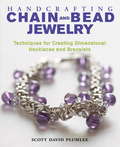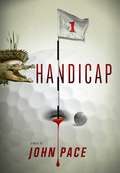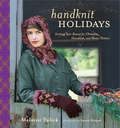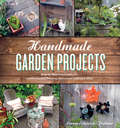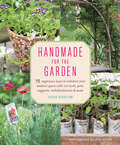- Table View
- List View
Handcrafting Chain and Bead Jewelry
by Scott David PlumleeHandcrafting Chain and Bead Jewelry shows how to create beautiful, dimensional silver, copper, and brass chains using simple tools. The main style is based on the elegant, classical Byzantine pattern, and uses the Golden Ratio to determine the circumference of a chain's interlocking rings based on the thickness of the wire. Illustrated step-by-step directions show how to calculate the circumference of the rings, how to wrap wire into coils, how to cut, and finally, how to assemble the chain. Starting from the basic Byzantine, new chain makers can then progress to increasingly Byzantine variations, including linear, knot, crown, and combination chains. Incorporating beads and charms offers endless possibilities for crafters who will soon, surely, be locked up in chains!
Handgun Buyer's Guide: A Complete Manual to Buying and Owning a Personal Firearm
by Brad FitzpatrickThe one-stop-shop for prospective handgun buyers. The market for new handguns is expanding rapidly, and that’s good news for consumers. Each year more and more new models break cover and there has never been a better time to be in the market for a new handgun, whether you’re a recreational shooter, a concealed carry permit holder, a hunter or a serious competitive shooter. Today’s handguns offer superb machining and utilize some of the most technologically-advanced alloys, polymers and finishes to help make the current crop of handguns lightweight, accurate, durable, and affordable. This increase in product offerings stem from new interest in handguns, primarily as a result of nationwide issuance of concealed carry permits. As laws have been enacted that protect the rights of gun owners and defend our personal liberties, more and more new shooters are showing up on the range. But first-time shooters and new concealed carry permit holders are not the only segment of the handgun market that is seeing growth and interest. Pistol competitions have become more popular and more advanced, evolving from slow-fire matches at local gun clubs to modern IPSC, IDPA and 3-gun competitions. Handgun Buyer's Guide will help both the bewildered new shooter find their feet and purchase a handgun, find the best accessories, and locate a place to practice on hone their skills. You'll find all you need for owning a handgun in the Handgun Owner's Guide!
Handguns for Self-Defense: A Guide to Choosing and Using Your Weapon
by David NashRegardless of your level of training or comfort around firearms, understanding and applying firearm fundamentals will increase your proficiency. Handguns for Self-Defense provides easily understood explanations of what shooters need to do to fire more accurately. Author David Nash has more thann twenty years of experience as a firearm instructor and in this book he explores such topics as: • How to choose the firearm, holster, and carry method that best fits you, your lifestyle, and your particular protection needs • Understanding state and federal firearm laws • Developing and implementing a safe and effective firearms training regime • How to deal with friends and family who don’t like guns • And much more All of this is done without politics, judgments, or complex explanations. Handguns for Self-Defense is a valuable resource for anyone thinking about purchasing a firearm for the first time, exploring carrying a gun for self-defense, or seeking to improve the skills they already have.
Handicap
by John PaceWhen Thom finds a murdered body on the golf course, he can't rest until he solves the mystery of the heinous crime. And the cast of characters he meets along the way is anything but comforting.Thom hates standing just four-foot-seven (and a half!). After watching his mother bleed to death from a knife stuck through her heart, he runs away and lands in backwards backwoods Florida. There, he becomes an expert golfer. This is no small feat, and one he credits to his short game. Thom only golfs alone. It's where he escapes the scorn and ignorance of others. The course is Thom's World. Until, that is, he discovers a woman's bloody corpse on number two-stabbed through the heart. Then Thom's World becomes a black tunnel of terror and guilt. He can't even raise a club without collapsing in panic. Thom must solve the murder not only to escape suspicion, but especially to reclaim his glorious solitude. This, however, finally forces him to open up to others: like Dyleane, who sees Thom for what he is on the inside; Jade, the ample proprietor of a cafe and whorehouse; Father C, a chain-smoking priest with a pitiful toupee; and others still, who will stop at nothing to keep their secrets buried.
Handimals: Animals in Art and Nature
by Silvia LopezDiscover the beauty of Handimals: hands modeled and painted into animals paired with facts and photos of the corresponding animals in nature. With a gift for fine art and a lifelong love of nature, Guido paints magnificent animal subjects on an unconventional canvas—human hands. This awe–inspiring collection showcases sixteen creatures ranging from polar bears to alpacas to Komodo dragons and provides factual information about the various species. Silvia Lopez brings her sharp eye to these important animals with insightful facts to raise awareness and appreciation for Earth’s precious wildlife. A perfect choice for artists and environmentalists of all ages.Christy Ottaviano Books
Handknit Holidays: Knitting Year-Round for Christmas, Hanukkah, and Winter Solstice
by Melanie FalickThe author of Knitting in America offers more than 50 winter knitting projects—from classic holiday decorations to stylishly original gifts. For many people, the best part of the winter holidays is the anticipation: planning the perfect gifts, decorating the house, looking forward to seeing family and friends. Holidays can be particularly special for knitters, whose preparations often start months in advance and involve their own creations. In Handknit Holidays best-selling knitting author Melanie Falick presents an eclectic collection of more than 50 original gifts, decorations, and clothing pieces for Christmas, Hanukkah, and the winter solstice, providing year-round inspiration for knitters of all levels. Created by top knitwear designers, the projects include colorful ornaments; funky and classic Christmas stockings; a wire-and-bead menorah; sparkly ribbon scarves; a poncho and matching dog sweater; and a range of super-quick projects for that last-minute holiday rush, from a Santa hat, to elf caps, to flower pins. Rounding out the volume are a few grand projects—an Aran tree skirt, a patchwork afghan, a lace shawl—destined to become family heirlooms, plus features on such topics as the origin of the Christmas stocking, the meaning of the winter solstice, knitting for charities, strategies for finishing holiday knitting (on schedule!), and even a delicious recipe for festive crescent cookies. Beautifully photographed by Susan Pittard, Handknit Holidays is a creative celebration of the holiday season and a treasure for all knitters who seek to bring more of their own handwork—and artistry—into their daily lives and their holiday festivities.
Handling Edna: The Unauthorised Biography
by Barry HumphriesThe real story behind Dame Edna, the international superstar!In this unauthorised biography of Dame Edna Everage, acquired for an unprecedented advance and in spectacular secrecy, her long-time manager and the man who was there from the very beginning, Barry Humphries, takes a behind-the-scenes, no-holds-barred look at an icon of our times. Superstar, swami, confidante and advisor to royalty, Hollywood stars and international political leaders, Dame Edna's life has catapulted her from her humble Moonee Ponds beginnings as a suburban housewife to the most elite social and artistic circles in the world. Who would have thought that this modest Australian woman could achieve so much from London to Louisiana to New York to Tokyo? Who could have anticipated her global fame? Barry Humphries certainly didn't.Dame Edna may not like this book but Barry knows everything - the who, the why and the where - and in this much-anticipated work, for the first time, he reveals all. This exhaustively researched account of Edna's roller-coaster life is essential reading for scholars, female achievers, fans of Dame Edna and those who feel that behind the fairytale career lies a darker and more sinister story...
Handling Edna: The Unauthorised Biography
by Barry HumphriesIn this unauthorised biography of Dame Edna Everage, acquired for an unprecedented advance and in spectacular secrecy, her long-time manager and the man who was there from the very beginning, Barry Humphries, takes a behind-the-scenes, no-holds-barred look at an icon of our times. Superstar, swami, confidante and advisor to royalty, Hollywood stars and international political leaders, Dame Edna's life has catapulted her from her humble Moonee Ponds beginnings as a suburban housewife to the most elite social and artistic circles in the world. Who would have thought that this modest Australian woman could achieve so much from London to Louisiana to New York to Tokyo? Who could have anticipated her global fame? Barry Humphries certainly didn't.Dame Edna will not like this book but Barry knows everything - the who, the why and the where - and in this much-anticipated work he will, for the first time, reveal all. This exhaustively researched account of Edna's roller-coaster life will surely dominate the bestsellers lists. Essential reading for scholars, female achievers, fans of Dame Edna and those who feel that behind the fairytale career lies a darker and more sinister story.(p) 2010 Orion Publishing Group
Handmade Bags In Natural Fabrics
by Emiko TakahashiMake your own charming handbags with this fashionable Japanese sewing book.There is no better project for the eco-conscious crafter than a simple cloth bag. Handmade Bags in Natural Fabrics offers patterns for twenty-five basic bag styles along with sixty variations and the know-how to customize each bag to suit any style-from sweet-and innocent to minimalist to counter-culture.Emiko Takahashi, a fashion and textiles designer, provides easy instructions and bag sewing diagrams, as well as a sheet of fully-sized pattern pieces for each handmade bag project-plus easy lessons on the basics of hand-stitching drawstring casings, corners, edges, straps, and simple flourishes. Cotton and linen bags are always useful and they lend a carefree, laid-back touch to any warm-weather outfit. Each bag can be machine-sewn, but they are designed to be made in natural fabrics that are lightweight enough to be easily sewn by hand. With Takahashi's expert guidance, beginning sewers with little or no previous experience can learn to make these understated and elegant handbags.Sewing patterns include: Envelope Pouches Bucket Bags Picnic Totes Sacks and carryalls Classic DrawstringsJapanese craft books enjoy a cult following in the United States, and Handmade Bags in Natural Fabrics has all the elements of a classic in the making.
Handmade Bags In Natural Fabrics
by Emiko TakahashiMake your own charming purse, tote, clutch, satchel or eco tote with with this fashionable Japanese sewing book.There is no better project for the eco-conscious crafter than a simple cloth bag. Handmade Bags in Natural Fabrics offers patterns for twenty-five basic bag styles along with sixty variations and the know-how to customize each bag to suit any style-from sweet-and innocent to minimalist to counter-culture.Emiko Takahashi, a fashion and textiles designer, provides easy instructions and bag sewing diagrams, as well as a sheet of fully-sized pattern pieces for each handmade bag project-plus easy lessons on the basics of hand-stitching drawstring casings, corners, edges, straps, and simple flourishes. Cotton and linen bags are always useful and they lend a carefree, laid-back touch to any warm-weather outfit. Each bag can be machine-sewn, but they are designed to be made in natural fabrics that are lightweight enough to be easily sewn by hand. With Takahashi's expert guidance, beginning sewers with little or no previous experience can learn to make these understated and elegant handbags.Sewing patterns include: Envelope Pouches Bucket Bags Picnic Totes Sacks and carryalls Classic Drawstrings
Handmade Bags in Natural Fabrics
by Emiko TakahashiThere is no better project for the eco-conscious crafter than a simple cloth bag. Craft book Handmade Bags in Natural Fabrics offers patterns for twenty-five basic bag styles along with sixty variations and the know-how to customize each bag to suit any style-from sweet-and innocent to minimalist to counter-culture. Emiko Takahashi, a fashion and textiles designer, provides easy instructions and diagrams, as well as a sheet of fully-sized pattern pieces for each handmade bag project-plus easy lessons on the basics of hand-stitching drawstring casings, corners, edges, straps, and simple ?ourishes. Cotton and linen bags are always useful and they lend a carefree, laid-back touch to any warm-weather out?t. Each bag can be machine-sewn, but they are designed to be made in natural fabrics that are lightweight enough to be easily sewn by hand. With Takahashi's expert guidance, crafters with little or no previous experience can learn to make: - Envelope Pouches - Bucket Bags - Picnic Totes - Sacks and carryalls - Classic DrawstringsJapanese craft books enjoy a cult following in the United States, and Handmade Bags in Natural Fabrics has all the elements of a classic in the making.
Handmade Bags in Natural Fabrics
by Emiko TakahashiMake your own charming handbags with this fashionable Japanese sewing book. There is no better project for the eco-conscious crafter than a simple cloth bag. Handmade Bags in Natural Fabrics offers patterns for twenty-five basic bag styles along with sixty variations and the know-how to customize each bag to suit any style-from sweet-and innocent to minimalist to counter-culture. Emiko Takahashi, a fashion and textiles designer, provides easy instructions and bag sewing diagrams, as well as a sheet of fully-sized pattern pieces for each handmade bag project-plus easy lessons on the basics of hand-stitching drawstring casings, corners, edges, straps, and simple flourishes. Cotton and linen bags are always useful and they lend a carefree, laid-back touch to any warm-weather outfit. Each bag can be machine-sewn, but they are designed to be made in natural fabrics that are lightweight enough to be easily sewn by hand. With Takahashi's expert guidance, beginning sewers with little or no previous experience can learn to make these understated and elegant handbags. Sewing patterns include: Envelope Pouches Bucket Bags Picnic Totes Sacks and carryalls Classic Drawstrings Japanese craft books enjoy a cult following in the United States, and Handmade Bags in Natural Fabrics has all the elements of a classic in the making.
Handmade Chic: Fashionable Projects That Look High-End, Not Homespun
by Laura BennettIn Handmade Chic: Fashionable Projects That Look High-End, Not Homespun, Laura Bennett shares simple strategies for creating 40 small luxuries and high-fashion accessories, from a smart leather iPad portfolio to a feather-embellished evening bag. With sections organized in skill-building order and based on type of accessory—small leather goods, agendas and notepads, electronics, bags and wallets, and evening items—Laura offers patterns, easy-to-follow diagrams, and detailed instructions for fabricating each glamorous project, whether it involves sewing from scratch or embellishing a prepurchased garment. While showcasing her own creative designs, she provides readers with the basic techniques and encouragement they need to come up with variations and create their own signature pieces.Packed with Laura's signature flair and finesse, vibrant four-color photos, step-by-step drawings, and a complete list of suggestions on where to purchase materials, Handmade Chic is an accessible guide to at-home crafting that is elegant enough for the most modern, fashion-savvy of women.
Handmade Garden Projects: Step-by-Step Instructions for Creative Garden Features, Containers, Lighting and More
by Lorene Edwards ForknerYour journey to a made-from-scratch outdoor space starts here. Transform your yard into a beautifully personalized retreat with 30 step-by-step projects! The finished pieces include creative pathways, unique support structures, DIY water features, clever containers, and special finishing touches that help bring your garden to life. With easy to follow instructions, lush color photography, and sidebars filled with helpful tips and additional ideas, Handmade Garden Projects is an inspiring step toward a more stylish space.
Handmade Hellos
by Eunice Moyle Sabrina Moyle Sarah LabieniecSigned, sealed, delivered! In this delightful book, card-making mavens Eunice and Sabrina Moyle of Hello!Lucky letterpress gather together more than 25 projects from today's most talented paper artists. Simple instructions outline card- and envelope-folding basics plus how to screen print, use a Print Gocco machine, hand-bind, emboss, stamp, stencil, and much more. Ready-to-use patterns and spiral binding ease the process while easy-to-follow directions, cute illustrations, and finished project photos make it a cinch to create stacks of boutique-worthy greeting cards.
Handmade Holiday Cards from 20th-Century Artists
by Faythe Levine Mary SavigHandmade Holiday Cards shows how artists imagined the holidays through original watercolors, etchings, silk-screen prints, and drawings. Rarely seen beyond the eyes of their recipients, these cards confirm the irrepressible artistry of their senders. Handmade Holiday Cards offers personal insight into the style and sentiment of artists, including how they summed up the year's events in their own lives and the world in which they lived.The introduction by archives specialist Mary Savig explores the intersections between commercial holiday cards and the art world--how holiday cards were first marketed as "affordable art" and how selling their art to card companies often provided income for artists in lean times. She then opens up the more intimate dimensions of an artist's social network, illuminating their relationships with dealers, curators, teachers, and close friends. Captions introduce each artist, compare or contrast the holiday card to his/her body of work, and discuss the relationship to the recipient when relevant.Handmade Holiday Cards illustrates and contextualizes a broad range of one-of-a-kind artworks or limited edition print series by well-known artists such as Josef Albers, Milton Avery, Alexander Calder, Robert Indiana, John Lennon and Yoko Ono, Robert Motherwell, Nickolas Muray, and Ad Reinhardt. It will appeal to anyone interested in greeting cards, ephemeral art, illustrated correspondence, and the history of American art.
Handmade Home: Simple Ways to Repurpose Old Materials into New Family Treasures
by Amanda Blake SouleFor many of us, our home is the center of our life. It is the place where our families meet and mingle, where we share our meals and share our dreams. So much more than just a space to live, our homes offer us a place of comfort, nourishment, and love for us and for our children.In Handmade Home, Amanda Blake Soule, author of The Creative Family and the blog SouleMama.com, offers simple sewing and craft projects for the home that reflect the needs, activities, and personalities of today's families. As Amanda writes in the introduction, "As a crafter, I'm always looking for the next thing I want to make. As a mama, I'm always looking for the next thing we need--to do, to have, to use--as a family. The coming together of these parts is where the heart of Handmade Home lies."Filled with thirty-three projects made by reusing and repurposing materials, all of the items here offer a practical use in the home. From picnic blankets made out of repurposed bed sheets to curtains made out of vintage handkerchiefs, these projects express the sense of making something new out of something old as a way to live a more financially pared-down and simple life; lessen our impact on the earth; connect to the past and preserve a more traditional way of life; and place value on the work of the hands. Also included are projects that children can help with, allowing them to make their own special contribution to the family home.More than just a collection of projects for handmade items, this book offers the tools to create a life--and home--full of beauty, integrity, and joy.Projects include: * Papa's Healing Cozy: This hot water bottle cover becomes a simple way to offer comfort to a sick child * Baby Sling: A simple pattern for an object that offers so much to a small child--refuge from the world and a place to lay their head next to a parent's heart * Beach Blanket To-Go: Repurpose old sheets to create the perfect picnic blanket for special outdoor meals * Cozy Wall Pockets: A creative solution for storing a child's small treasures Pattern templates for Handmade Home
Handmade Houseplants: Remarkably Realistic Plants You Can Make with Paper
by Corrie Beth Hogg Christine Han<p>In Handmade Houseplants, expert crafter and tastemaker Corrie Beth Hogg offers a no-water option for your urban jungle: plants made from paper! <p>This stylish guide includes step-by-step instructions and templates for making 30 of the most popular houseplants, from monstera and peperomia to fiddle leaf fig and philodendron. Additional projects show how to use paper plants for home décor, wall art, holiday decorations, gift giving, and more. The projects are simple enough to be made in few hours and the materials are affordable and easy to find. <p> Packed with colorful photos and filled with inspiration, Handmade Houseplants shows how paper plants can provide a modern, light-hearted touch to a well-designed home.</p>
Handmade Personalized Photo Gifts
by Carla VisserPhotographs always evoke strong emotions with those special moments caught on camera--this book shows you over 75 fabulous ways to display your photographs on virtually any surface!Using the very latest trends, techniques and materials this books shows you how photos can be added to practically any surface to create unique gifts. Project ideas include: canvas prints, bottles, plates, mugs and jars, jewelry, cushions, blankets, toys and puzzles.Step-by-step photographs will both teach and inspire you to create amazing results--so give your creativity free rein and fill your life with your special moments.
Handmade Soap Book: Easy Soapmaking with Natural Ingredients
by Melinda CossThe master soap maker shares her methods for creating sumptuous, all-natural skin care products with no special equipment needed.In a world filled with pollution, the products we use on our bodies ought to offer cleansing—not chemicals. This book shows you how to create your own soaps and bathtime luxuries using only natural ingredients and common kitchen equipment. These products make the perfect gift for family, friends, kids, and grown-ups. And they’re an ideal gift for yourself as well. This book features a huge range of tempting ingredients, such as peach, peppermint, ylang ylang, cinnamon and chocolate. It includes recipes for shampoo bars, body splashes and bath creams. The easy-to-follow recipes and luscious photography will be an inspiration to anyone who cares about what they put on their skin.
Handmade Weddings: More Than 50 Crafts to Personalize Your Big Day
by Eunice Moyle Sabrina Moyle Joseph De Leo Shana FaustHandcrafted details are at the heart of a beautiful wedding adding charm, meaning, and style. In this delightful book, Eunice and Sabrina Moyle, the founders of Hello! Lucky, join forces with stylist Shana Faust to bring you over 50 gorgeous projects. Whether you favor a modern, classic look or a retro, homespun flavor, you'll find plenty of crafts and inspiration suited to your taste from vintage-key save-the-dates to delicate paper wreaths to silhouette bride and groom signs.At the front of the book you'll find guidance on choosing a look, sourcing materials, and working out timelines. Then, each of the 50 projects are fully explained with photos, how-to diagrams, and step-by-step directions. Clever, creative, and budget-friendly, Handmade Weddings is the perfect handbook for the bride looking to style her day her way.
Handmade for the Garden: 75 Ingenious Ways to Enhance Your Outdoor Space with DIY Tools, Pots, Supports, Embellishments, and More
by Susan GuagliumiA collection of seventy-five one-of-a-kind, affordable, and manageable DIY projects for the garden. The DIY craze has moved beyond the craft room and into the garden! Relying on easy-to-find, inexpensive, and repurposed materials, Handmade for the Garden is a treasure trove of original projects that not only make planting and growing efficient and successful but also add a personal touch to the gardenscape. Among the myriad projects in this hardworking book are mini hothouses; painted, stamped, and stenciled terracotta planters; hypertufa and cement pots and decorations; rustic and formal fencing and trellises; plant markers and stakes; and sieves and baskets. With Handmade for the Garden to inspire them, gardeners of all skill levels will be empowered to experiment with form and function to discover creative, artful ways to personalize and beautify their gardens with handmade objects.&“This book is bursting with beautiful and creative ways of using everyday materials to liven up your outdoor spaces&” ―Country Woman Magazine &“This book adds new dimension to playing outside . . . if you love the garden, tinkering with tools and creating beautiful objects for out-of-doors, this is your book.&” ―Examiner.com &“Any person with a modicum of entry-level crafting skills can add individual flair to their garden following the descriptive step-by-step instructions. . . . Many illustrations depict precise details in the fabrication process. A source list, with website addresses, will prove useful to those who cannot find supplies at their local home improvement center.&” ―Better Homes and Gardens / Country Gardens
Handmade in Cuba: Rolando Estévez and the Beautiful Books of Ediciones Vigía
by Ruth Behar Juanamaría Cordones-Cook Kristin SchwainHandmade in Cuba is an in-depth examination of Ediciones Vigía, an artisanal press that published exquisite books crafted from simple supplies during some of Cuba’s most dire economic periods. Vividly illustrated, this volume shows how the publishing collective responded to the nation’s changing historical and political situation from the margins of society, representing Cuban culture across the boundaries of race, age, gender, and genre. In this volume, poets and scholars reflect on the unique artistic direction of Rolando Estévez, who oversaw the creation of over 500 handmade books and magazines between 1985 and 2014. They highlight the beautiful designs and unusual materials selected, including fabric, metals, wood, feathers, and discarded items. Through diverse perspectives, including an interview with Estévez himself, the essays showcase the unlimited inventive possibilities of books as objects, as sculptural pieces, and as installations. Even in the age of technology, Estévez generated enormous excitement and admiration for these hand-crafted books, and this volume offers the first inside view of this important alternative publishing space. Contributors: Ruth Behar | Juanamaría Cordones-Cook | Gwendolyn Díaz | Erin Finzer | William Luis | Nancy Morejón | Kim Nochi | Carina Pino Santos | Kristin Schwain | Elzbieta Sklodowska
Handmade to Sell: Hello Craft's Guide to Owning, Running, and Growing Your Crafty Biz
by Kimberly Dorn Sara Dick Christine Ernest Kelly RandBusiness advice for enterprising crafters, by crafters No one knows more about helping handmade businesses than Hello Craft, the nonprofit trade association for crafty entrepreneurs. Written by the directors of Hello Craft, Handmade to Sell is the most complete, up-to-date, and authoritative guide for DIYers seeking to learn every aspect of selling, marketing, and branding. Based on the Summit of Awesome, Hello Craft's annual business conference, this book covers topics including:* Developing successful product lines* Copyrights and trademarks* Taking perfect product shots* Using analytics to boost your online sales* Selling at fairs, shows, and other retail outlets* Diversifying income through licensing and teaching* Hiring and outsourcing Throughout, you'll find expert tips and invaluable strategies and advice from some of the most successful indie crafters and artisans. Whether you've only contemplated selling your crafts or want to grow an existing handmade business, Handmade to Sell offers essential guidance for anyone who has ever dreamed of making a living from what they create.
Handpicked: Simple, Sustainable, and Seasonal Flower Arrangements
by Ingrid Carozzi Eva NyqvistBrooklyn-based florist Ingrid Carozzi reveals her secrets for creating flower arrangements that are modern, original, and organic in style. Organized by season, the book presents simple step-by-step instruction (how to measure, cut, and place each bloom) for making more than 35 arrangements. Whether you want to learn how to work with chicken wire and tape to create a simple framework or try your hand at arranging delicate and oversize blooms, Carozzi offers a detailed tutorial on her tricks of the trade. Readers are encouraged to source, make, or upcycle unexpected containers, such as rough-hewn wooden crates or vintage pots, jars, and vases. Full of natural floral compositions that marry the modern with the rustic, Handpicked is a lushly photographed, practical guide to creating your own exceptional flower arrangements at home.
